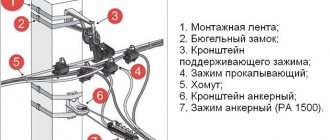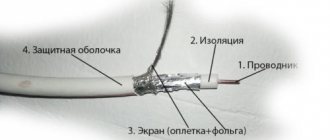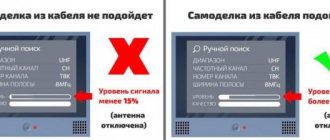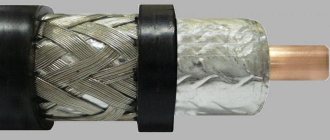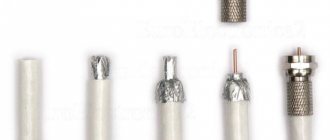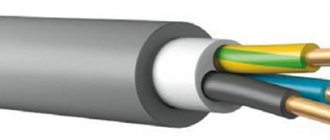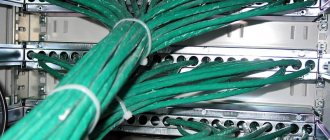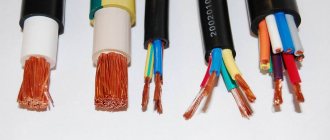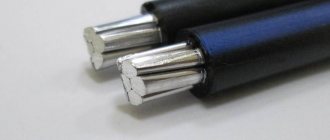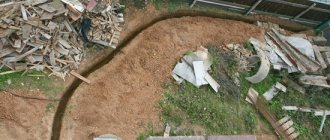The quality of digital television broadcasting directly depends on the cable used. Sometimes, due to a cable with a high level of signal attenuation, a person cannot watch his favorite TV shows normally. The stores offer dozens of models of cables of different cross-sections, dielectric quality, conductor composition and shielding layer. How to choose an antenna cable for digital television so that everything works like a charm? Let's discuss the best brands of television cables. If you are not interested in theory, but need to quickly select a cable, click here.
The structure of a television cable
Speaking about the internal structure, we can say with certainty that all models have similar content.
- Inner conductor - it can be made as a single or stranded wire, copper tube. The signal range and possible bending radius depend on the material.
- Dielectric layer – ensures the immobility of conductors. It can be made of polyethylene, fluoroplastic, foamed polyvinyl chloride or an air layer. The characteristic impedance and attenuation of the transmitted signal depend on the quality of the material.
- The outer conductor is braided. Made from foil, corrugated tube, aluminum film, metal wire. The degree of protection from external electromagnetic interference depends on the quality of the material.
- A sheath that protects the internal structure of the cable.
As you can see, the principle of cable structure is the same, but the materials from which its structural parts are made differ from each other. How to choose a good option that matches the technical characteristics of modern television broadcasting?
Antenna cable device
The manufacturing principle of all cables is almost identical. It is based on a central core (inner conductor); braid or a special screen serves as insulation. The structures are wrapped in a protective shell. The operation of coaxial wires is based on the transmission of a pulse by an internal conductor to power the converter in satellite TVs.
The cable base is made of copper or copper-plated steel rod. The second option is cheaper and copes well with its responsibilities. A pure copper core is needed only for satellite pairing of the transmitter and receiver. Screen protection or braiding is designed to reflect various types of interference. The material for these parts is an aluminum element at 60-90 dB.
The internal polymer dielectric is responsible for protecting the embedded core, preventing possible deformations. In addition, the plastic insulates the braid and screen, and the outer PVC sheath protects the entire wire from external influences (liquid, dirt, dust, temperature changes).
How does a television cable work?
Analyzing the structural features, it is possible to say with a high probability that absolutely all models have approximately the same concept of internal structure:
- The inner conductor is made of solid wire, copper tubing, or multi-strand material. The quality of the material determines the signal reception distance, as well as the permissible bending indicator.
- The dielectric layer acts as a conductor clamp.
- The external conductor is braided. Often made of foil and thin wire. Quality affects the level of protection against external factors, such as electromagnetic interference.
- The inner sheath provides protection for absolutely all structural elements of the cable.
Thus, the types of television cables differ little in structure. Of course, there are certain features, but mainly they manifest themselves in the quality of the material from which this or that element is made.
Which TV cable is better to choose? The answer to this question directly depends on your goals. For example, if the signal distance is minimal, then there is no point in overpaying for an expensive coaxial cable conductor. In general, television cables and their varieties are universal, as they are suitable for satellite, digital and analogue broadcasting.
Lived
A central wire that resembles a core when cut crosswise. The composition is made of copper or alloys. The first option is preferable for safety reasons - copper is more susceptible to heating and has a high level of thermal conductivity. Consequently, if there is a short circuit or overcurrent is applied to the cable, rapid heating and an increase in resistance will occur, to which the TV fuse will immediately react. Steel alloys in this case will be less effective.
It is also advisable to choose a thicker core (~1 mm), because As the diameter increases, the attenuation coefficient decreases.
Screen
An outer conductor that prevents the signal from being attenuated by propagating outside the cable. Its functions are comparable to that of a satellite dish reflector. Today there are three screen options - foil, aluminum film and wire braid. The latter option for making a screen is less expensive and such cables are the cheapest. However, the outer wire is not solid, which greatly increases the attenuation coefficient. It is possible to use such a cable for digital television only when using an indoor antenna. Significant signal loss is guaranteed when the distance from the receiver to the TV is more than 1 m.
Foil and film are solid screens that reduce the attenuation coefficient to zero. This cable is recommended for connecting terrestrial and satellite television with an outdoor antenna. Foil would be preferable, but remember that it is not flexible and will break if bent too hard. If you choose to install an antenna on the roof of an apartment building, you need a long cable for wiring to the apartment and strong bends are planned, you will have to buy a cable for the most expensive TV, the screen of which consists of foil with a surface braid. In this case, it is used to protect the screen from damage at the bend points.
Shell
Insulating material made from HDPE or PVC. It can be white or black, less often gray. You can choose a cable for TV without being particularly interested in the casing, because... it does not affect the system characteristics of the cable. It is recommended to consider a denser material (since it is less susceptible to wear and heat), but within reasonable limits, because as it increases, flexibility decreases.
Plug
There are two types of plugs on the market: in a single design and in the format of a screw with a nut. In the latter case, it is enough to expose the cable and insert it inside the plug, then tighten it. This method is perfect for those who are not electrically versed and want to quickly connect the antenna wire. If you have the skills to use a soldering iron, it is safer to purchase a plug in a single design and solder the wires.
The best antenna splitters for 2 TVs
To connect multiple TVs at once, use the best TV splitters. Let's look at them in more detail below.
PROconnect
This splitter is a coaxial option for satellite television with various quality characteristics. It can not only be used for two TVs, but also for interconnection and interconnection in public places. Can also be used to connect household radio devices or various types of surveillance cameras.
High-quality materials are used for production, which ensure stable data transmission without interference or distortion.
The outer covering is made of polyvinyl chloride, so you can install the splitter outdoors. It does not deform under the influence of ultraviolet radiation.
The length can be about 10, 20 and 50 m. There is a plug on each side for connection.
REXANT
This splitter model is used to connect several TVs or surveillance cameras. Total length – 100 m.
The splitter is characterized by high-quality insulation. Polyvinyl chloride was used for its manufacture. Black color. The disadvantage of this model is that it does not have connectors.
Now you know which antenna cable for satellite television is best to choose. It all depends on the installation location, the distance between the receiver and the receiver, the required signal quality, and price.
A lot of interesting information is on the video.
Marking
When you buy a domestic product, there are usually no difficulties with its designation.
- RK – radio frequency cable;
- 75 – conductor resistance 75 Ohm;
- 4.8 – diameter;
- 34 – the first digit shows the insulation group, heat resistance category. The second digit is the serial number of the development;
- TU – technical manufacturing conditions.
But the labeling of imported cables can be confusing. Meanwhile, here is the definition of Western standards:
- DELINK – manufacturer;
- SAT-752 – name;
- Cu/Cu – material of the central conductor and braid (Cuprum – copper);
- 1.13 – thickness of the central core;
- 0.12*64 – thickness and density of the braid;
- Cu-foil – full copper;
- Coaxial cable – coaxial cable;
- 75 OHM – conductor resistance 75 Ohm;
- ISO 9001—2000 – certificate of conformity.
What is important when choosing
The choice of cable for a TV antenna is based on 7 main factors:
- Outer shell material. In the production of feeders, two options are used - PVC and light-stabilized (that is, resistant to ultraviolet rays) polyethylene. PVC is ideal for use inside an apartment (for example, when connecting to a communal antenna or cable TV). But for external laying nothing better than polyethylene has yet been invented. An unsuitable type of coating will lead to cable damage and breakdown.
- Strength of the outer layer. It is enough to try the outer PE or PVC sheath on a section of the feeder by pulling it towards you. If it moves easily, there is no need to use the cable: bending may damage the screen.
- The length of the route along which the cable channel will pass. The longer, the greater the loss of signal power due to conductor resistance. Therefore, where you need to lay a long route (10 m or more), it is better to use a cable with a copper central core rather than a steel one;
- Incoming signal power. Reception of terrestrial relay television broadcasts of the DVB-T2 standard provides the equipment with sufficiently powerful impulses, the same applies to cable TV. But the signal strength coming from the satellite is low. Therefore, for dishes it is better to choose cables with a copper core.
- Diameter of the central core. The thicker it is, the less loss during signal transmission. However, conductors that are too thick may require special adapters in order to be used in standard connectors.
- Cable thickness. Typically, the more powerful the feeder, the more layers of shielding are used, the thicker the central core and the more reliable the insulation. However, this is only an indicative sign. A high-quality, thin cord may be better suited for installation than a thick, low-quality cord. We'll talk about this below.
- Material of the central core. Copper transmits the signal better, clad steel is stronger. It’s easy to check what the core is made of: you need to take a magnet and bring it to the cable. If there is attraction, it means steel, if there is no attraction, it means copper.
Additionally, you can look for the following signs:
- Reviews of specific brands. It’s better to look at TV master forums rather than in online stores: there’s a greater chance that a particular review was not paid for, but was compiled on the basis of practical experience.
- Manufacturer. There are several brands whose products have no complaints (for example, the Italian company Cavel). For others, you need to look at the parameters of a specific brand.
What cable parameters should you pay attention to?
Insulated metal strands that conduct information to video and audio-reproducing connected equipment are characterized by several parameters. These include:
- conductor cross-section and material;
- signal attenuation and gain coefficient;
- wave resistance.
To transmit digital information, the wire resistance must be observed. It must be at least 75 ohms. The cable cross-section depends on the distance to the signal receiver. For example, for a multi-storey building, an average of at least 30 meters is typical. Then the conductor should be about 1 mm in diameter. If this is a private house, then a cross-sectional area of 0.5-0.9 square meters is sufficient. mm.
Regarding the material, both copper, steel, aluminum, and copper-plated alloys cope with conductivity. But manufacturers do not always provide information about attenuation, but this happens rarely. More often than not, the signal amplification factor is sufficient. For good quality, 60-80 dB is enough; with a footage of more than 25 meters, it will be possible to achieve an ideal image with a value exceeding 90 dB. But this is not always necessary.
The last criterion on which the choice of wire is based is the allowable flexibility of the cable. If it contains a core with a cross-section of less than 1 mm and the screen is represented by foil or film, then the risk of fracture of the core and screen increases already at an angle of 45⁰. This phenomenon is eliminated by a thicker core and additional metal braid.
Choosing a cable for digital TV
Today on trading platforms you can find many options that meet certain parameters for high-quality digital television. But only a few of them meet all the requirements. Here are some examples:
- Inexpensive wire from China, Russian design. A copper-plated steel conductor or only a copper conductor transmits the signal quite well. It is labeled as RG-6U. The overall diameter is just under 7mm. The flexible antenna
cable has a resistance of about 9 dB per 100 linear meters. But the weak point is the PVC shell, which limits the scope of application to the internal lining in a heated room with constant humidity. - The domestic analogue of RK-75 is represented by a variety of cores ranging from 0.75 to 1.63 square meters. mm in cross section. Among the recommendations, the application is monitored for a satellite
signal with a relatively thick conductor (from 1 sq. mm). The cable is approved for installation in conditions of -/+ 60 degrees Celsius and the flexibility of the sheath is less susceptible to cracking. - Italian technologists presented the Sat-50 cable with a copper core with a diameter of about 1 mm. This is a high-quality coaxial
conductor, which is surrounded by an aluminum and foil screen. They compensate for interference and enhance the signal by an average of 60 dB. The declared service life is 15 years, taking into account the climatic conditions of central Russia outside. - Sat-703 in the cross-section of the core is increased by 0.13 square meters. mm and is more often used for wiring cables over 50 m long. Here the gain is 80 dB, which allows you to distribute information over several points without loss of quality. The sheath corresponds to the aggressive behavior of nature, so laying such a wire inside the building is not necessary from the point of view of economy.
- DG-113 is designed for transmitting any signal: digital, satellite, cable
television.
Its characteristics
are higher than those listed due to copper braiding and double foil. The coefficient is 90 dB. At the same time, the total cross-sectional area of the wire is only 1.13 square meters. mm. the durability of such a cable is also superior to analogues both for internal and external installation.
There is another option suitable for digital broadcasting. RG-59 has a thin core with a cross-section of up to 0.58 mm. This cable can only be used indoors with a minimum number of turns. This is explained by the fragility of the core and the high signal attenuation coefficient. If there is more than one TV in the house, then it is better to choose RG-6U.
Types of television wires
If there is only one antenna cable, then there are many types of television wires. Each of them differs in the way they display information and in appearance.
Attention! Do not confuse the antenna and television wires. The first ones are used to receive a digital signal, while the others are needed to display images and sound on the TV in the usual form.
Coaxial
The most common type of antenna cables, which were already discussed at the beginning of the article. One has only to add that coaxial cables include not only antenna cables, but also any electrical wires that in their architecture include a central core (there may be several of them), a screen (external conductor) and insulating material. Coaxial cable is more common not only for terrestrial TV, but is also used by providers to organize a cable TV network.
Composite
This type includes any cable that has more than one connector. The name reflects the multi-tasking nature of the wire, i.e. transmission of several signal formats at once. In the case of television, this is a separate output of image and sound to the TV after decoding. Typical representatives of composite wire are RCA and AV cables for TV. They are also used to connect a video player, speakers and other audio-video devices to a receiver or TV.
Component
Externally, such wires are similar to composite cables, but their operating principles are very different. All present inputs output an image, and only one of them transmits an audio signal along with the video. Component cables have higher bandwidth compared to their composite counterparts. They are not intended to be connected with separate video and audio outputs, i.e. are not compatible with digital TV and are used to watch multimedia from a storage device or interactive television.
HDMI | DVI
With the development of wide-screen digital television, broadcasting in 4K format (~4000p) became available. Despite pre-compression to digital, broadcasting ultra-high definition images requires transmitting a large amount of information. The previously existing wires did not have sufficient bandwidth, so a new cable was developed - hdmi. If the TV and receiver have a connector for this type of television cable, the TV devices support high-definition image output and it is recommended to connect them using an HDMI cable.
Modern Smart TVs and receivers are comparable in capabilities to a computer and have a powerful video adapter of 1 GB or more. Although they also have an HDMI connector, to support video games and other graphics applications, you need to connect from a video card that has a VGA connector. A DVI cable is used for this.
Which cable is better to use to connect the set-top box, it is better to focus on the maximum pixel resolution of the TV, because When connecting wires with a higher bandwidth, it will not increase the clarity of the broadcast, but will increase the power consumption of the receiver.
Choosing a cable for the main types of TV
There are several modern types of television broadcasting, ranging from terrestrial to satellite. The last type of TV will be discussed separately; as for the others, it makes no sense to select a cable separately for each type.
The broadcast frequency of cable channels, digital and terrestrial TV is in a fairly narrow range from 40 to 800 MHz. It is perfectly covered by all the listed brands. With a conductor length within 30 m, the loss of quality is almost unnoticeable even in inexpensive models. For this reason, you can safely purchase one cable for any television except satellite.
Coaxial cable design
Although coaxial cable may differ in conductor material and insulation quality, all types have approximately the same design:
- PVC insulation . It is resistant to ultraviolet radiation and protects the shielding layer and conductor from mechanical stress. May be black or white. Previously, black cable was intended for installation outside the window, and white cable inside the house. However, now manufacturers have moved away from such markings and now the insulation of almost every cable of any color can withstand environmental factors.
- Braided screen . The braid can be made of aluminum or copper wires. The thickness of each wire usually does not exceed 0.12 - 0.16 mm2.
- Foil screen . Along with the braiding, it protects the signal passing inside the wire from external interference. It can be single or double.
- Polyurethane dielectric.
- Conductor . The conductor can be made of pure copper or copper-plated steel. The first is more expensive and is usually used for satellite TV (although it is also suitable for others), while the second is cheaper and can be used for digital and terrestrial television broadcasting.
Choosing a cable for satellite TV
What kind of cable is needed for a satellite dish? The frequency of satellite channels plays a big role here; they are higher and the measurement takes place in thousands of megahertz. It is important to achieve transmission without significant loss of quality.
It is worth adding to this that the cable transmits special impulses and through it power is supplied to the converter. The quality loss of the satellite signal increases rapidly as the conductor lengthens. It is also quite sensitive to external interference.
For this reason, special requirements are placed on conductors for satellite TV. Only models SAT 703, DG 113 or similar characteristics can provide proper transmission conditions.
The general requirements for a cable for receiving satellite TV are as follows:
- the main core is made of copper;
- low signal attenuation;
- high quality outer shell.
The best TV cables according to reviews
The table shows products that enjoy well-deserved respect among professionals. Most of the technical characteristics of low current cables are taken into account, making the right choice easier. All types are coaxial type, most have universal use: in surveillance systems and for connecting to the Internet.
Depending on the cross-sectional diameter, the cables can be thin flexible (thin, resistance 50 Ohm, used for connecting local networks) or thick rigid (thick, Ø 12 mm, for transmitting signals over long distances). They are marked RG (Radio Guide scale), SAT (products of the Italian company CAVEL) or RK (domestic manufacturers of cables with a resistance of 75 Ohms and more).
RG-6
The cross-section of the central wire is 1 mm, it can be copper or copper-plated steel. Has two protective screens: aluminum foil and tinned copper. The domestic market contains mainly Chinese products.
Pros:
- Large range of types - can operate in the range up to 3 GHz, which expands the scope of use
- There are options with a steel core - stretching and sagging are reduced, the number of fixation points is reduced
- Shielding factor up to 90 dB – minimizes signal distortion
Minuses:
- Outer shell made of ordinary polymer - reacts extremely negatively to UV rays, only for indoor use
- The diameter of the core varies along the length - the cable must be purchased with a reserve cross-section
- Low parameters at frequencies ≤ 50 MHz – the quality of the digital picture noticeably deteriorates, not suitable for HDTV
RK 75
Analogue of RG-6 of domestic production. The copper central core is single-wire, thickness 1.0 mm. The insulating material is porous PE of physical foaming. The screen is made of copper braid or aluminum lavsan and tinned copper. The minimum cost per meter is 10 rubles.
Cable RK 75
RG-59
Universal cable (for digital and analogue television networks and video surveillance), the inner sheath is polyethylene, the outer sheath is polyvinyl chloride. The price is lower than RG-6, resistance is 75 Ohms. Screen made of copper wire, surface filling density 95%. Linear capacitance 53 pF/m, mismatch attenuation 20 dB.
Pros:
- Wide temperature range (-30°С–+80°С) – can be used in all climatic regions
- Copper center conductor - minimal resistance reduces signal power loss
- Diameter 6.2 mm - simplifies installation of networks in closed channels
Minuses:
- Bend radius 3 cm – difficulties arise when laying networks with complex geometries
- 2GHz Frequency Range – Application Options Are Reduced
- Core diameter 0.6 mm – losses increase critically at large distances
SAT-703
It has double shielding and a copper conductor, and is resistant to the adverse effects of atmospheric factors and sunlight.
Core diameter 1.13 mm, PEG dielectric, minimum bending radius 35 mm, with multiple bending diameter increases to 70 mm. Allowable breaking force is 150 N. Class B shielding, loop resistance does not exceed 40 Ohms, maximum current does not exceed 8 A. Pros:
- High reliability indicators - the cable can be used for difficult operating conditions
- Minimum resistance - it is possible to increase the length of lines without loss of signal quality
Minuses:
- Great popularity among users - there are a lot of counterfeit unlicensed products on the market
- Large diameter - the weight of the feeder increases; additional measures must be taken during installation
SAT-50
The conductor is made of copper and has two screens (foil and copper wire). External insulation made of polyvinyl chloride, internal insulation made of polyethylene foam. Used to transmit digital and analogue television signals. External diameter 6.8 mm, resistance 75 Ohm, core diameter 1 mm.
Pros:
- Insulating shells made of modern innovative polymers – areas of use and installation methods are not limited
- Braided using new technology – increases screen efficiency
- Relatively low cost – increased availability for various consumers
- Stability of parameters along the length - simplifies calculations and improves signal quality
Minuses:
- Insufficient interference protection - not recommended for industrial use
- Thin outer shell – large distances between attachment points are not allowed
DG 113
Technical standards are close to SAT 703. An excellent option for a satellite dish inside a building. The wire has a high shielding value - from 90 dmb, which facilitates the transmission of high quality impulses. Failures and interference in operation are practically excluded. The average service life is more than ten years. It is considered the most expensive - from 65 rubles per meter.
Cable DG 113
Brands and characteristics
All television cables have a single architecture for each, because... it must be strictly followed to ensure a specific output format. Antenna wires, on the contrary, come in a wide variety.
Their difference is in physical characteristics that determine the mode and service life:
- RG-6U. A universal brand of cable in terms of price/quality ratio. It has a copper core and good double insulation, which gives maximum bending possibilities and a low attenuation coefficient. This wire has a significant drawback - a mediocre level of wear due to the manufacture of the sheath from low-density polyethylene. The RG-6U cable will be the most successful choice for laying indoors under an indoor antenna.
- SAT-50. The most popular brand of antenna cable in Russia. The core is made of copper, and the screen is made of aluminum film with copper braiding. The insulation is made of high-density plastic, resulting in a service life of 15 years. The SAT-50 TV cable perfectly receives signals from the repeater and satellite thanks to the central core with a diameter of 1 mm.
- DG-113. Brand of the most expensive antenna cable. The core and insulating material have characteristics similar to SAT-50. The difference between this cable is an improved screen with a signal amplification factor of up to 90 dB. Such a cable is needed in cases where there is a long distance from the antenna to the TV (for example, when installing on the roof of an apartment building). When laying up to 40 m, interference and image distortion are not observed.
- SAT-703. An analogue of the SAT-50 brand cable, designed for operation in harsh climatic conditions. Its peculiarity is a core made of steel alloys, which heats up more slowly and is more resistant to temperature changes. The cost of the SAT-703 is also comparable to the SAT-50. At the same time, it is better not to buy such a wire for a room, because... this will be an extra expense.
Tips for use
To avoid premature wire failure, adhere to the following recommendations:
- When choosing an antenna cable to your TV for residential connection, you should buy a model with high wave capacity.
- For outdoor installations in regions with extreme weather conditions (abnormal heat, excessive temperature fluctuations, increased precipitation, too low temperatures), choose wires with special impregnation.
- During the installation process, you should not make too many solders and connections, as this will negatively affect the quality of the signal. Laying a single wire is the optimal solution.
- You should not use home-made splitters; it is more advisable to acquire a proprietary device. In addition, splitters and signal amplifiers should be located in accessible places - it is possible that a breakdown will occur over time, and repairs will be carried out accordingly.
- During the installation process, follow the manufacturer's recommendations. This is especially true for the bending radius and the distance between fasteners.
- Under no circumstances should a coaxial cable be laid close to electrical appliances - this may cause interference.
The expert advice offered will help you make the right choice. As a result, you will achieve the highest possible quality of connection to television equipment.
Sources
- https://tehnika.expert/cifrovaya/televizor/vybor-televizionnogo-kabelya.html
- https://ProSmartTV.ru/tehnologii/koaksialnyj-televizionnyj-kabel.html
- https://prosmartv.ru/receiving/televizionnyj-antennyj-kabel-dlya-tv.html
- https://tvdigitally.ru/efirnoe-tsifrovoe-televidenie/kakoj-kabel-luchshe-sem-prakticheskih-sposobov-proverki-kachestva
- https://ProDigTV.ru/efirnoe/antenna/kabel-dlya-tsifrovogo-televideniya
- https://cifrovoetv-rf.ru/digital-television-cable-which-is-better/
- https://resiverplus.ru/kakoj-kabel-nuzhen-dlya-antenny
- https://vyborok.ru/qa/electronics/televizionnyj-kabel-kakoj-luchshe.html
- https://teleinside.ru/antennyj-kabel-dlya-televizora/
Installation and operation
The antenna cable for the TV is quite resistant to external factors. If there are fluctuations in temperature outside, you should opt for a wire with a steel core, due to its low thermal conductivity. Indoors, on the contrary, it is better to use a copper core. It is extremely important to take into account such nuances, since resistance increases with heating. It helps reduce signal speed. Even the densest double screens offer negligible attenuation rates. So, you need to reduce the distance between the antenna and the TV tuner or purchase an amplifier. In this case, the power consumption of the receiver increases.
Correct installation of coaxial cable for a TV
Modern receivers include fasteners and clamps for simplified connection. However, the most reliable and proven installation method is soldering.
Cable bending problems
One or another bending option implies a significant deterioration in the signal level. This can be avoided by placing the cord at an angle of 90°. However, this increases the absorption of the wire and the risk of destruction of the screen at this point.
Experts recommend, if possible, to avoid sudden changes in the shape of the product. You should adhere to a smooth change of direction within the limits of acceptable flexibility.

